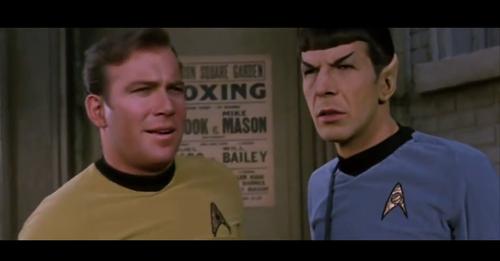Full disclosure: I think Harlan Ellison is a very bad writer in many readily identifiable ways. Most important, his work shows his own psychological problems almost always. If you happen to share that sector of emotional, imaginative issues, I say, Good, and enjoy.
I have come to find it difficult to justify certain choices authors and artists seem to make for no other than reason they have a subconscious fascination with something I might not be embarrassed to let pass through my mind but certainly would be embarrassed to say let alone write about.
That is perhaps something for another discussion. But to cases. What is wrong with this perfectly adored episode (The City on the Edge of Forever) of a revered sci fi TV show?
The story begins with some problems on the bridge of the starship Enterprise which result in Dr. McCoy accidentally injecting himself with enough of some imaginary substance to make him bonkers and paranoid and also capable of fighting his way off the bridge, into the transporter room, and onto some planet the ship happens to be orbiting for some reason.

Someone has to go after him. Let us pause and ask why? Oh, that’s right, he’s, like, the third most important person in the universe of this show. Naturally, those going after him are Kirk, Spock, Uhura, Scotty, and I think there are two disposable guys wearing red shirts, likely security guys. Maybe there are three of them. I don’t know why. They really don’t do anything in the episode. Spoiler alert: They don’t even die.
On the planet there’s a talking arch which is a portal into time. As if my front door isn’t that. But serious as Bones on crack and PCP, this is an oval that shows images as if in a movie out of past times. The channel apparently is set to Earth time for the benefit of the guests. The arch lays it all out, and then suddenly when the most important characters in this universe have understood what they’re looking at, Dr. McCoy manages to get through the arch.
There may have been some interruption. The three nobodies grab and subdue the good doctor, but the strength of the drugs coursing through his system like planets through the ether propel him to jump into the portal. And like that, Keyser Söze has made the whole universe disappear. No ship, no Federation, no beach to walk on. And what of Lazarus, and what of Lazarus?
To make a long intro short, of course someone has to go after him. Not only to restore the universe as they know and love it, but hell, that guy’s one of the Triumvirate. Naturally again it’s the two most important characters, Spock and Kirk. But they leave instructions for the other next most important persons to follow if they don’t come back.
This setup is ludicrous. This order, this plan, is like going to the casino: “If we don’t win at craps, each of you will step up and shoot crap until we have all gone bust.” In comparison, I think with almost nostalgia of Wells’ The Time Machine.
Kirk and Spock hop through the portal. Much hemming and speculation about whether anyone will be able to find anyone in this way has occurred, enough to keep the imaginations of the audience engaged, and no one even thinks to crack jokes about the absurdity and imprecision.
Oh, come on! We all know there’s no story unless they find each other. “Time has eddies and backwaters; the same currents will drive us to the same…” Okay, Spock, we get it. We can always count on Spock to be the narrator of “common sense,” not so much logic in the real-world sense, but of the probable in the fictional universe and, therefore, of the inevitable in the scripting. When Spock talks, you should listen up, people!
Next, after a series of hijinks, involving the pilfering of someone else’s laundry and a cop, Kirk and Spock encounter Joan Collins playing some Salvation Army Mission dame. I am reminded of Guys and Dolls and half hope someone will turn this into a musical. I think it would work.
Spoiler alert, it turns out this woman running her mission during a time of economic upheaval (“It was called ‘The Depression” – thank you again, Mr. Spock!) is in fact the rendezvous point for our top three guys in the show’s universe.
She is some visionary peacenik who, if she lives, will convince FDR not to enter WWII, and that will let the Nazis complete their heavy water experiments and, with their V2 rockets to carry “the bomb,” they will win WWII. Spock chimes in again, the narrative voice of pure reason.

So, if the Nazis had won WWII, there would be no Federation, no Kirk, no Spock, no McCoy? Hmm. Paradox there, right? Well, let’s not overthink a badly conceived concept. Let’s just follow the loop in time premise to its illogical conclusions. If necessary Spock can say something lugubriously weighty.
But, wait, let me get this straight: The previously interrupted chronology involves the death of some visionary woman who advocates peace so persuasively that she can convince a bloodthirsty warmonger like FDR and all the others who are itching for a scrap not to enter the war? I mean, what happened after Pearl Harbor?
The script could’ve included that this woman also convinced the Japanese not to do all the invading and stuff. Thus, it was only the Nazis Joan Collins’s character, Edith Keeler, couldn’t get to in time. Such a persuasive doll, a mission doll, could charm the swastika right off a hardcore fascist, I’ll bet!
Not only that, but apparently it is therefore her fault, and hers alone, in the inevitabilities of this conceit. The Nazis win unless she gets hit by a truck, after which all’s right again with The Enterprise cruising the heavens and Kirk in his captain’s chair?
The truth about justice, and peace, and morality is closer to the story in the movie The Lookout (q.v.). When it comes to war and violence, and injustice, we are all more than a little traumatized. There’s a famous correspondence between Einstein and H. G. Wells about war. Or was it Carl Jung? Regardless, guys like that, like Kirk, Spock, and McCoy, they are pen-pals worth reading, right?
The late historian and WWII airman, Howard Zinn, does a great job of showing how Einstein and Wells are not the sharpest tools across the board when it comes to understanding things in ordinary human spaces and times.
Spoiler alert: It’s a sad correspondence with not particularly bright insights. Maybe it was late, and their best insights had been used up earlier in the day. But here’s the thing: The only way to arrive at just outcomes, at peaceful outcomes, is to start at the end, what you want, and work backwards.
You can’t murder your way to peace or pave a path to justice with injustice. Likewise, the notion that letting some random person die in a traffic accident will result in the right outcome, not blaming the Nazis or others, is the foulest piece of time propaganda I can think of off the top of my head.
To be clear, I am not saying it would have been better if the USA had delayed getting into WWII or not gotten in at all. This is a piece of fiction, a fictional future and characters from the future, going back to a fictional past, to make sure a fictional character dies in order that real history comes out the way it should.
Yeah, that Harlan Ellison could certainly tie one on! But you should check out A Boy and his Dog. And didn’t he also do Damnation Alley? Let me jump through a time portal and find out.
My favorite, however, is a short story, Jefty Is Five, which is another fantasy featuring time, with the world going back to his childhood while the narrator is spending time with this magic kid. I could argue that Ellison has a weird fascination and nostalgia going on.
But we are far from finished here. Wait for it. It’s not going anywhere near what you’re thinking.

